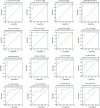Elevated plasma levels of selective cytokines in COVID-19 patients reflect viral load and lung injury
- PMID: 34676126
- PMCID: PMC7107806
- DOI: 10.1093/nsr/nwaa037
Elevated plasma levels of selective cytokines in COVID-19 patients reflect viral load and lung injury
Abstract
A recent outbreak of pneumonia in Wuhan, China was found to be caused by a 2019 novel coronavirus (2019-nCoV or SARS-CoV-2 or HCoV-19). We previously reported the clinical features of 12 patients with 2019-nCoV infections in Shenzhen, China. To further understand the pathogenesis of COVID-19 and find better ways to monitor and treat the disease caused by 2019-nCoV, we measured the levels of 48 cytokines in the blood plasma of those 12 COVID-19 patients. Thirty-eight out of the 48 measured cytokines in the plasma of 2019-nCoV-infected patients were significantly elevated compared to healthy individuals. Seventeen cytokines were linked to 2019-nCoV loads. Fifteen cytokines, namely M-CSF, IL-10, IFN-α2, IL-17, IL-4, IP-10, IL-7, IL-1ra, G-CSF, IL-12, IFN-γ, IL-1α, IL-2, HGF and PDGF-BB, were strongly associated with the lung-injury Murray score and could be used to predict the disease severity of 2019-nCoV infections by calculating the area under the curve of the receiver-operating characteristics. Our results suggest that 2019-nCoV infections trigger extensive changes in a wide array of cytokines, some of which could be potential biomarkers of disease severity of 2019-nCoV infections. These findings will likely improve our understanding of the immunopathologic mechanisms of this emerging disease. Our results also suggest that modulators of cytokine responses may play a therapeutic role in combating the disease once the functions of these elevated cytokines have been characterized.
Keywords: 2019-nCoV; COVID-19; IL-17; IP-10; cytokine storm.
© The Author(s) 2020. Published by Oxford University Press on behalf of China Science Publishing & Media Ltd.
Figures




References
LinkOut - more resources
Full Text Sources
Other Literature Sources
Research Materials
Miscellaneous
